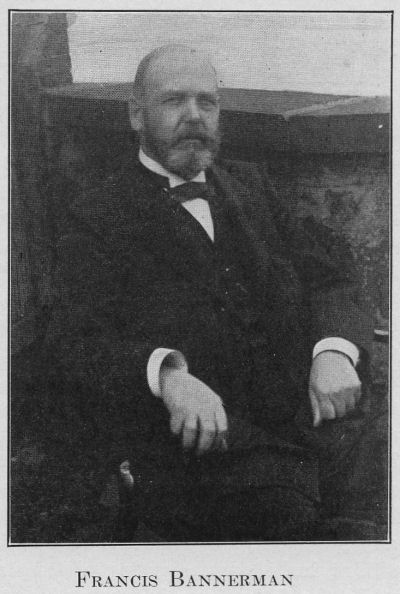FRANCIS BANNERMAN, the noted
merchant and authority on war weapons, is the sixth Frank from the first
Frank Bannerman, standard-bearer of the Glencoe MacDonalds, who escaped
the massacre of 1692 by sailing to the Irish coast. His descendants
remained in Antrim for 150 years, intermarrying with Scottish settlers. In
1845, Mr. Bannerman's father removed to Dundee, Scotland, where Francis VI
was born, March 24, 1851. He came with his parents to the United States in
1854 and has resided in Brooklyn since 1856. The eldest son in each
generation is always named Frank. The surname originated at Bannockburn,
where an ancestor rescued the clan pennant, whereupon Bruce cut off the
streamer from the Royal ensign and conferred upon him the honour of
"bannerman."

Young Francis left school at ten,
when in 1861 his father went to the war. He secured employment in a
lawyer’s office at two dollars a week, each morning, before going to the
law-office, supplying with newspapers the officers of the warships
anchored off the Brooklyn Navy Yard, near his home. Summer evenings, after
work hours, he dragged the river with a grapple for bits of chain and
rope, which he sold to junkmen. When his father returned disabled, he
became a dealer in the material the boy collected, with a storehouse at 18
Little Street, also attending the Navy auctions, and later established a
ship-chandlery business at 14 Atlantic Avenue. Frank went back to school
for a time and won the scholarship for Cornell University, but could not
accept owing to his father’s war disability requiring his assistance in
carrying on the business.
In 1872, Francis began business for
himself, attending army auctions and, noting the destruction of useful and
historic war weapons for old metal, began buying them and sending out an
illustrated catalog to collectors. He also supplied frontiersmen with
fowling-pieces made over from the old army rifles, which he also altered
into Quaker guns for boys’ brigades and military schools. The Assistant
Chief of Ordnance stated that "Bannerman has done so much good toward
training the youth of America with his Quaker drill guns that the United
States could well afford to pay him a bounty on each gun made." He opened
stores in New York City first at 118 Broad Street, then 27 Front Street,
and finally, in 1897, at 579 Broadway, where he fitted out many regiments
for the Spanish-American War. After the war, he purchased from the United
States Government over 90 per cent. of the captured war material, and
bought historic Polopel’s Island, in the Hudson Highlands opposite
Cornwall, known to the public as Bannerman's Island, and erected large
arsenals patterned after the Scottish baronial castles. This beautiful
island, 13 acres in extent, he also makes his summer home. In 1905, he
bought 501 Broadway from the trustees of the Metropolitan Museum, who
greatly "reduced the price in recognition of his maintenance of a Free
Public War Museum." The building has seven floors, 40,000 square feet,
devoted to museum and salesroom. The collection contains ancient and
modern weapons from every country covering hundreds of years. All his
goods are sold on Government auction sale terms—cash with order. Even the
Standard Oil Company in purchasing had to send check with order.
Mr. Bannerman is not only the
largest dealer in the world, but is the acknowledged founder of the
military goods business and the foremost authority on military supplies.
His illustrated catalog, of more than 400 pages, is known to collectors as
the best book on the subject. At the request of the Government, he has in
preparation a History of War Weapons. He originated the "sealed
bid" plan of selling obsolete Government stores. His goods go all over the
world. A large number of transactions have been with Central and South
American countries; but he has consistently refused to sell to
revolutionists, or to minors or irresponsible persons—he recently
cancelled a large order, and refunded the money, when he discovered it was
from revolutionists. His stock and facilities are so extensive that he
once converted a large ocean steamer into a warship and delivered it in
one week. At the outbreak of the European War, in 1914, in seven weeks he
supplied the French Army with 8,000 saddles, and as a loyal Scot, donated
thousands of rifles, cartridges, etc., to the British Army.
While on a business trip to Europe
in 1872, he visited his grand- mother in Ulster. There he met Helen Boyce,
of Huguenot-Scotch-Irish descent, to whom he was married, June 8, 1872, in
Ballymena, by Rev. Frederick Buick who had married his father. They have
three sons: Frank VII, David Boyce, and Walter Bruce; one daughter died in
infancy. The two eldest sons are in business with their father. Walter
Bruce is a physician in Bridgewater, Mass.
Mr. Bannerman is a most genial and
energetic man. Notwithstanding his busy life, he is active in
philanthropic and Christian work. He is a great lover of boys, and in
connection with boys’ club church work for years has devoted one evening
in the week to studying with them the Sunday-School lesson. He is a member
of the St. Andrew's and many other societies, and was an organizer and one
of the first trustees of the Caledonian Hospital.

